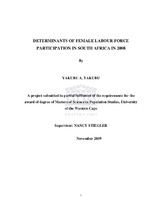| dc.description.abstract | South Africa’s female labour supply increased substantially over almost the past two decades. Female labour force participation is an imperative indication of the extent to which females participate in the economic activities of any country. Female Labour Force Participation (FLFP) rates have gained interest among researchers and development specialists worldwide due to their significant contribution in measuring progress related to gender disparities across various economic settings. Amsden (1980) further posits that there has been an increase in women contribution to modern sector
activities. Despite the advances in female educational attainment and the expansion of the market economy, FLFP rates are still low in comparison with the rates of their male counterparts. This study employs the Human Capital Theory (HCT), which postulates that the education of women is positively related to the likelihood of their labour force participation, in order to investigate quarterly dynamics in the labour force. This approach is an advancement of knowledge gained from previous studies such as Serumanga-Zake and Kotze (2004) and Ntuli (2004) who investigated the annual dynamics in FLFP. Investigating quarterly dynamics in FLFP is prudent as the market economy is very dynamic particularly at a point when the world economy is experiencing recession. Data for the study are extracted from the 2008 Quarterly Labour Force Survey conducted by Statistics South Africa. Logistic regression analysis modeling was employed with the dependent variable, FLFP, as a binary outcome. Other variables controlled in the analysis are gender, population group, age, marital status, education status, sector, main industry, main occupation and province. The results show that there
is association between education status and FLFP status. Findings from this research are expected to contribute to the knowledge about trends in FLFP in South Africa and aid in planning of interventions aimed at improving the status of women as one of the critical steps in achieving the Millennium Development Goals. | en_US |

